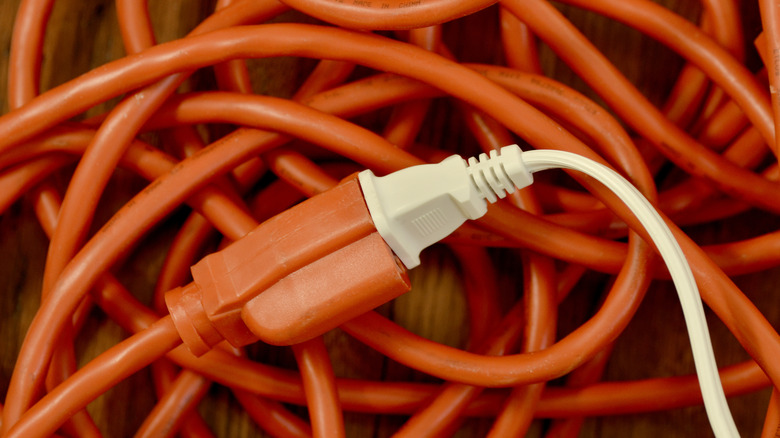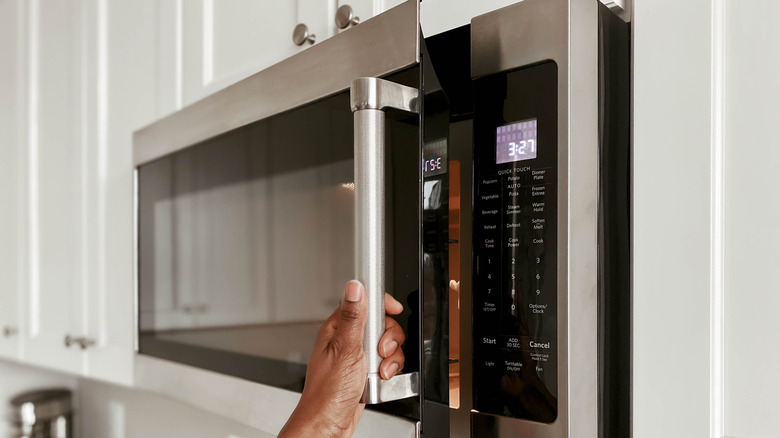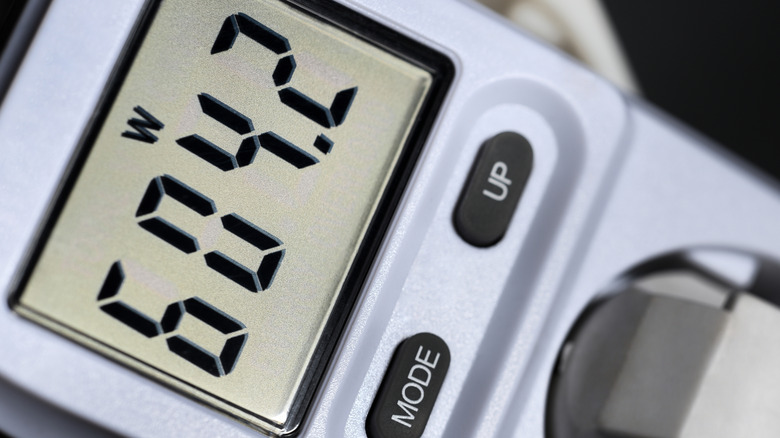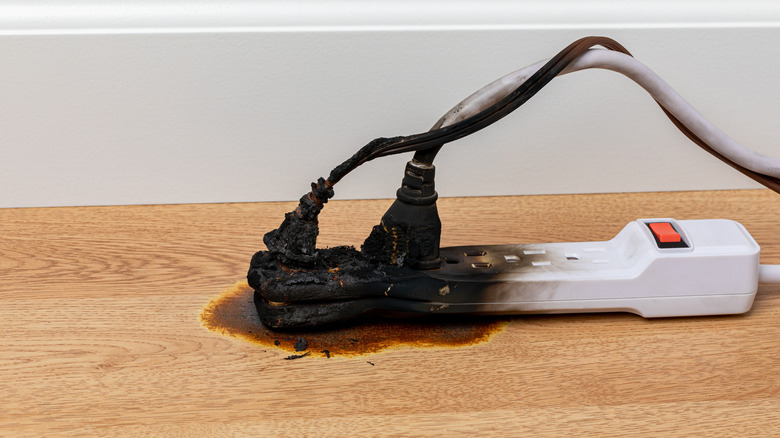Plugging These Appliances Into An Extension Cord Is A Major Fire Hazard
Chances are you have at least one extension cord in your house, but you might use it incorrectly. Plugging certain items into an extension cord can cause them to overheat, and may even cause a house fire. In fact, Electrical Safety Foundation International (EFSI) says an annual 3,300 home fires originate from extension cords, emphasizing the need for correct use. While there are many places you should never use extension cords, the appliances that you should avoid plugging into an extension cord include microwaves, air conditioner, refrigerators, and clothes dryers, all of which can be a major fire hazard.
Extension cords are handy for plugging in various small electronics, such as your smartphone or laptop, especially when you're in a space with an inconvenient outlet. However, they're meant only as temporary sources of power, and not meant to power appliances with high power consumption. Larger appliances, especially those like refrigerators or air conditioners, draw larger amounts of electrical current, but the extension cord isn't able to sustain the high demand; doing so is one of the biggest mistakes you may be making with extension cords. This is why it's important to avoid using a cord with these energy behemoths.
Why you can't use certain appliances with extension cords
Extension cords can be dangerous, and aren't suitable for operating microwaves, space heaters, and other appliances because of the consistent energy they require. An extension cord's construction can't adequately handle the consistent energy load of appliances, so they may eventually overheat, spark, and catch on fire. Not to mention, every extension cord can vary in its capacity, so you may select a light-duty extension cord to run a heavy-duty appliance, which could be a disaster if the cord gets too hot. Appliances such as washers or dyers, microwaves, space heaters, and even hair dryers are particularly susceptible to overheating in an extension cord, because there's already a high power demand. Because these items generate heat, it increases overheating risk and instead, they should plug directly into a wall outlet.
When you buy a new cord in the United States, each option lists a gauge. American Wire Gauge, or AWG, refers to the thickness of the conducting wire meant to carry power across a distance, with standard gauges available in 16-gauge, 14-gauge, 12-gauge, and 10-gauge cords. A lower number means a thicker wire, while a higher number indicates a thinner wire. The lower the gauge, the greater current capacity the cord offers. Each time you use an appliance with an extension cord, especially one with a lower gauge, you're putting uneven pressure for high electrical performance and making it more susceptible to overheating. In addition to never using extension cords with these appliances, you should pay attention to wattage levels of everything you plug into a cord.
Pay attention to wattage
Pay special attention to the maximum wattage and any intended devices you want to plug in to the cord. Every extension cord is sold with a small tag, which lists ratings from either the Underwriter's Laboratory (UL) or Electrical Testing Laboratory (ETL). The tags include wattage, voltage, and amperage, as do similar tags on nearly every appliance or electronic for sale in the United States. Wattage refers to the power consumption of a cord or appliance, while voltage is for the pressure of the actual power source to get the charge unit to a certain location, i.e. through the cord and to your device's power circuit. Amperage is also known as current, and is for the electrical charge's flow, specifically the volume that flows per second.
Extension cords often have a maximum for 10 amps or 1200 watts, according to Office of Compliance Safety and Health (OCWR). A hair dryer can use 1250 watts, but a window air conditioner with 10,000 BTU can consume 1200 watts during operation. As the AC cycles on and off throughout the day, it consumes a lot of watts, with higher rates based on the unit's size. A refrigerator has a lower wattage of 350 to 780 but also continually runs, so it's not feasible for extension cords. Clothes dryers are huge watt-eaters, with an average of 4350 watts. The exact wattage varies based on the appliance's energy efficiency features, model, and age, but general guidance is anything with consistent high wattage doesn't belong in a cord.
Never do this with your extension cord
Practice safe use of extension cords, such as never using an indoor cord outside to power a patio heater, string lights, or anything else. The design isn't made for outdoor use, plus it isn't sealed against moisture. Avoid covering any cord with a rug or carpet because this traps the heat, and may lead to a house fire. You should never attach a cord to the floor or wall with staples or tape, as this might damage the wiring. Before you use any extension cord, look carefully at its condition to check for any tears in the cover, a bent or broken plug head, and other defects.
Sometimes there is a definite lack of wall outlets in your space, and it can tempt you to connect, or "daisy chain," your cords together. This isn't a good thing or a "cool trick" to expand your power; instead, it causes heat generation in the cords. When you plug an extension cord into another cord, the combined effect means increased electrical resistance. Not only is this a severe fire risk, but it's also an Occupational Safety and Health Administration (OSHA) violation. You should also never connect an extension cord to a power trip for the same reasons. Overall, remember that extension cords are only meant for temporary use. Powering a device with one for more than 90 days officially shifts into permanent use. Improper or continual use of cords that results in a fire may lead to an insurance denial from your insurance company for negligence in fire safety.



